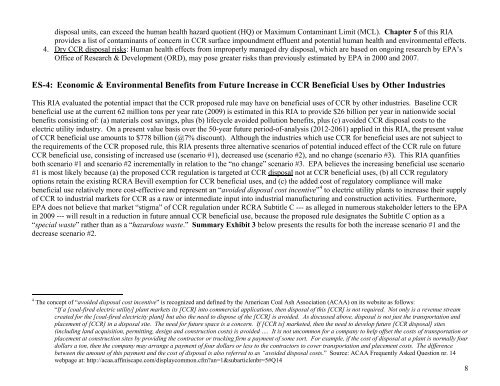Analysis - The Institute for Southern Studies
Analysis - The Institute for Southern Studies
Analysis - The Institute for Southern Studies
Create successful ePaper yourself
Turn your PDF publications into a flip-book with our unique Google optimized e-Paper software.
disposal units, can exceed the human health hazard quotient (HQ) or Maximum Contaminant Limit (MCL). Chapter 5 of this RIA<br />
provides a list of contaminants of concern in CCR surface impoundment effluent and potential human health and environmental effects.<br />
4. Dry CCR disposal risks: Human health effects from improperly managed dry disposal, which are based on ongoing research by EPA’s<br />
Office of Research & Development (ORD), may pose greater risks than previously estimated by EPA in 2000 and 2007.<br />
ES-4: Economic & Environmental Benefits from Future Increase in CCR Beneficial Uses by Other Industries<br />
This RIA evaluated the potential impact that the CCR proposed rule may have on beneficial uses of CCR by other industries. Baseline CCR<br />
beneficial use at the current 62 million tons per year rate (2009) is estimated in this RIA to provide $26 billion per year in nationwide social<br />
benefits consisting of: (a) materials cost savings, plus (b) lifecycle avoided pollution benefits, plus (c) avoided CCR disposal costs to the<br />
electric utility industry. On a present value basis over the 50-year future period-of-analysis (2012-2061) applied in this RIA, the present value<br />
of CCR beneficial use amounts to $778 billion (@7% discount). Although the industries which use CCR <strong>for</strong> beneficial uses are not subject to<br />
the requirements of the CCR proposed rule, this RIA presents three alternative scenarios of potential induced effect of the CCR rule on future<br />
CCR beneficial use, consisting of increased use (scenario #1), decreased use (scenario #2), and no change (scenario #3). This RIA quanfities<br />
both scenario #1 and scenario #2 incrementally in relation to the “no change” scenario #3. EPA believes the increasing beneficial use scenario<br />
#1 is most likely because (a) the proposed CCR regulation is targeted at CCR disposal not at CCR beneficial uses, (b) all CCR regulatory<br />
options retain the existing RCRA Bevill exemption <strong>for</strong> CCR beneficial uses, and (c) the added cost of regulatory compliance will make<br />
beneficial use relatively more cost-effective and represent an “avoided disposal cost incentive” 4 to electric utility plants to increase their supply<br />
of CCR to industrial markets <strong>for</strong> CCR as a raw or intermediate input into industrial manufacturing and construction activities. Furthermore,<br />
EPA does not believe that market “stigma” of CCR regulation under RCRA Subtitle C --- as alleged in numerous stakeholder letters to the EPA<br />
in 2009 --- will result in a reduction in future annual CCR beneficial use, because the proposed rule designates the Subtitle C option as a<br />
“special waste” rather than as a “hazardous waste.” Summary Exhibit 3 below presents the results <strong>for</strong> both the increase scenario #1 and the<br />
decrease scenario #2.<br />
4 <strong>The</strong> concept of “avoided disposal cost incentive” is recognized and defined by the American Coal Ash Association (ACAA) on its website as follows:<br />
“If a [coal-fired electric utility] plant markets its [CCR] into commercial applications, then disposal of this [CCR] is not required. Not only is a revenue stream<br />
created <strong>for</strong> the [coal-fired electricity plant] but also the need to dispose of the [CCR] is avoided. As discussed above, disposal is not just the transportation and<br />
placement of [CCR] in a disposal site. <strong>The</strong> need <strong>for</strong> future space is a concern. If [CCR is] marketed, then the need to develop future [CCR disposal] sites<br />
(including land acquisition, permitting, design and construction costs) is avoided …. It is not uncommon <strong>for</strong> a company to help offset the costs of transportation or<br />
placement at construction sites by providing the contractor or trucking firm a payment of some sort. For example, if the cost of disposal at a plant is normally four<br />
dollars a ton, then the company may arrange a payment of four dollars or less to the contractors to cover transportation and placement costs. <strong>The</strong> difference<br />
between the amount of this payment and the cost of disposal is also referred to as “avoided disposal costs.” Source: ACAA Frequently Asked Question nr. 14<br />
webpage at: http://acaa.affiniscape.com/displaycommon.cfm?an=1&subarticlenbr=5#Q14<br />
8




